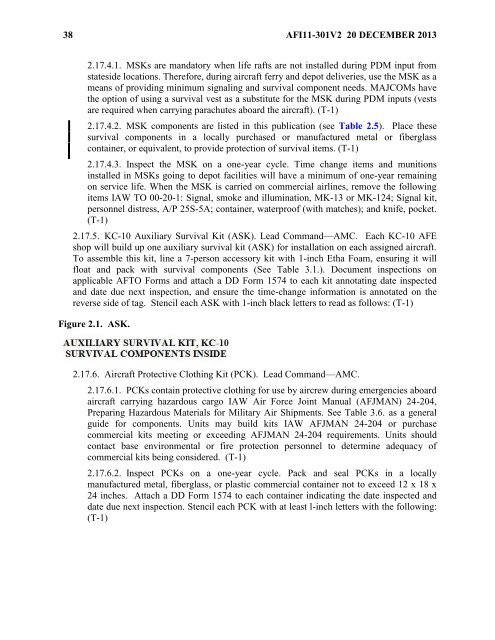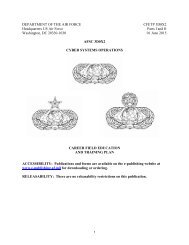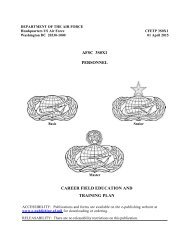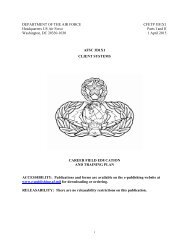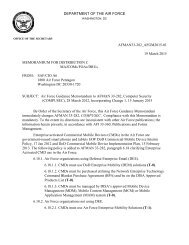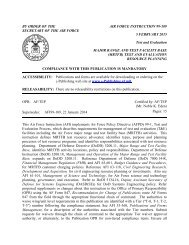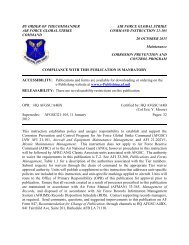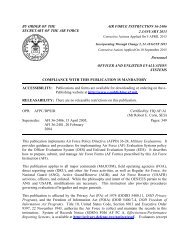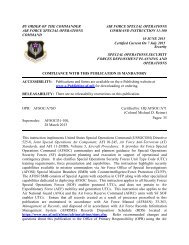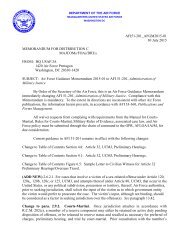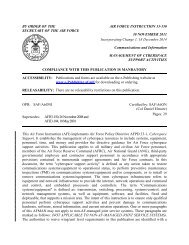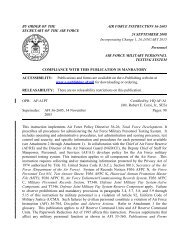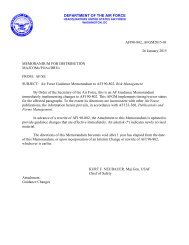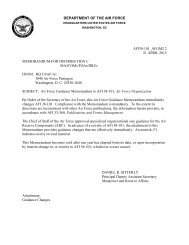COMPLIANCE WITH THIS - Air Force Link
COMPLIANCE WITH THIS - Air Force Link
COMPLIANCE WITH THIS - Air Force Link
Create successful ePaper yourself
Turn your PDF publications into a flip-book with our unique Google optimized e-Paper software.
38 AFI11-301V2 20 DECEMBER 2013<br />
2.17.4.1. MSKs are mandatory when life rafts are not installed during PDM input from<br />
stateside locations. Therefore, during aircraft ferry and depot deliveries, use the MSK as a<br />
means of providing minimum signaling and survival component needs. MAJCOMs have<br />
the option of using a survival vest as a substitute for the MSK during PDM inputs (vests<br />
are required when carrying parachutes aboard the aircraft). (T-1)<br />
2.17.4.2. MSK components are listed in this publication (see Table 2.5). Place these<br />
survival components in a locally purchased or manufactured metal or fiberglass<br />
container, or equivalent, to provide protection of survival items. (T-1)<br />
2.17.4.3. Inspect the MSK on a one-year cycle. Time change items and munitions<br />
installed in MSKs going to depot facilities will have a minimum of one-year remaining<br />
on service life. When the MSK is carried on commercial airlines, remove the following<br />
items IAW TO 00-20-1: Signal, smoke and illumination, MK-13 or MK-124; Signal kit,<br />
personnel distress, A/P 25S-5A; container, waterproof (with matches); and knife, pocket.<br />
(T-1)<br />
2.17.5. KC-10 Auxiliary Survival Kit (ASK). Lead Command—AMC. Each KC-10 AFE<br />
shop will build up one auxiliary survival kit (ASK) for installation on each assigned aircraft.<br />
To assemble this kit, line a 7-person accessory kit with 1-inch Etha Foam, ensuring it will<br />
float and pack with survival components (See Table 3.1.). Document inspections on<br />
applicable AFTO Forms and attach a DD Form 1574 to each kit annotating date inspected<br />
and date due next inspection, and ensure the time-change information is annotated on the<br />
reverse side of tag. Stencil each ASK with 1-inch black letters to read as follows: (T-1)<br />
Figure 2.1. ASK.<br />
2.17.6. <strong>Air</strong>craft Protective Clothing Kit (PCK). Lead Command—AMC.<br />
2.17.6.1. PCKs contain protective clothing for use by aircrew during emergencies aboard<br />
aircraft carrying hazardous cargo IAW <strong>Air</strong> <strong>Force</strong> Joint Manual (AFJMAN) 24-204,<br />
Preparing Hazardous Materials for Military <strong>Air</strong> Shipments. See Table 3.6. as a general<br />
guide for components. Units may build kits IAW AFJMAN 24-204 or purchase<br />
commercial kits meeting or exceeding AFJMAN 24-204 requirements. Units should<br />
contact base environmental or fire protection personnel to determine adequacy of<br />
commercial kits being considered. (T-1)<br />
2.17.6.2. Inspect PCKs on a one-year cycle. Pack and seal PCKs in a locally<br />
manufactured metal, fiberglass, or plastic commercial container not to exceed 12 x 18 x<br />
24 inches. Attach a DD Form 1574 to each container indicating the date inspected and<br />
date due next inspection. Stencil each PCK with at least l-inch letters with the following:<br />
(T-1)


